The scarlet snake is a small nocturnal species found burrowing in areas of dry sandy soils. With a bright mix of black, yellow, red, and white rings on its body, this harmless species is sometimes mistaken for the venomous coral snake –hence, it is sometimes referred to as false coral snake.
This snake also bears a striking resemblance to the scarlet kingsnake. All three multicolored species, the scarlet snake, the scarlet kingsnake, and coral snake, occur in the same habitats over the same geographic area. Of the three sympatric species, the scarlet snake is relatively tiny-bodied and slender. But some individuals have been found to grow larger than the average size of this species. What is the largest scarlet snake ever found? Read on to find out!
About Scarlet Snake
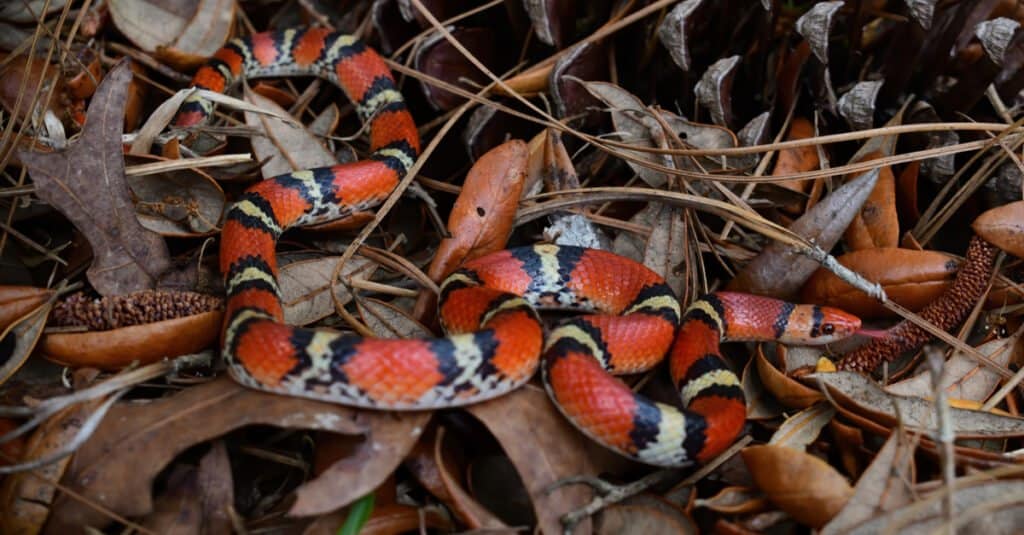
Scarlet snakes are native to the southeastern United States.
©Chase D’animulls/Shutterstock.com
The scarlet snake (Cemophora coccinea) is a species of small, nonvenomous snake belonging to the family Colubridae. It is native to the southeastern United States. There are two subspecies of scarlet snakes that are recognized as valid. They are; Cemophora coccinea coccinea (Florida scarlet snake) and Cemophora coccinea copei (northern scarlet snake).
What Do Scarlet Snakes Look Like?
The scarlet snake is a relatively small and slender snake that grows to a total length of 14-20 inches at adult size. The dorsal body is whitish-gray patterned with a series of red, white, or yellow black-bordered blotches down the back. The blotches can extend down the sides of the body, appearing somewhat like rings. Note that the red and whitish-gray blotches are separated by black, so they do not touch one another. The snake’s belly is either uniformly light gray or white. The red, black, and yellow pattern sometimes cause this species to be mistaken for other similar-looking species such as the harmless scarlet kingsnake or the venomous coral snakes. The scarlet snake has a small, pointed head that is barely distinct from the neck with a light-colored band just behind its eyes. The coloration of young scarlet snakes is similar to adults.
The Largest Scarlet Snake Ever Found
Most adult scarlet snakes average about 14-20 inches (36-51 cm) in total length and 2.77 lbs in weight. According to North Carolina records, the maximum recorded length for a scarlet snake is 2.75 feet (83.8cm).
Where are Scarlet Snakes Found?
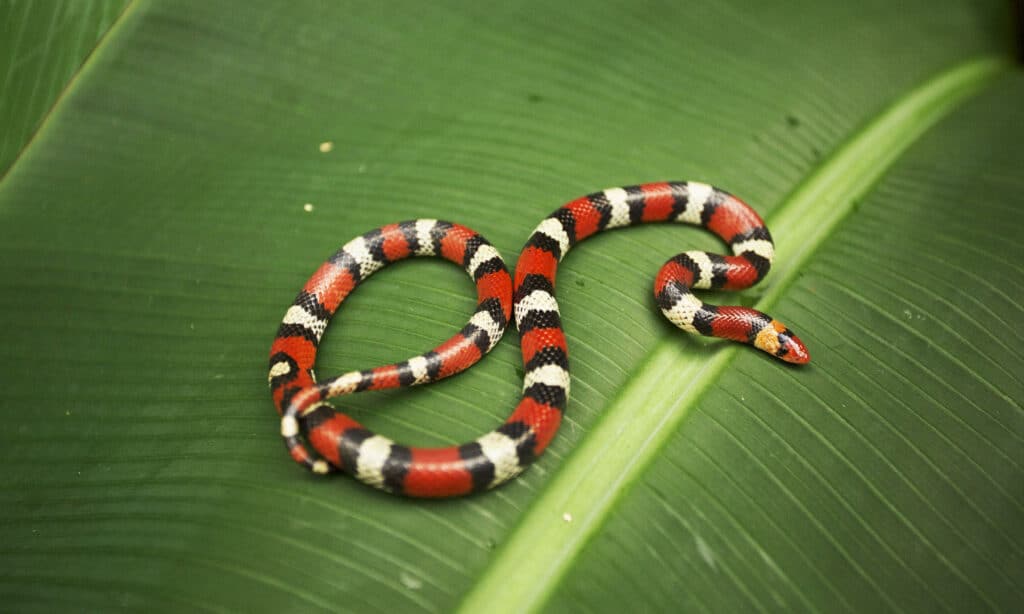
The scarlet snake’s range extends throughout most of the coastal plain areas of the Atlantic.
©Fine Art Photos/Shutterstock.com
Scarlet snakes are found throughout the United States. Their range extends throughout most of the Atlantic Coastal Plain areas. In the US, this species is distributed across southeastern Texas, parts of Louisiana, eastern Oklahoma, Florida, Mississippi, Alabama, Arkansas, Tennessee, Georgia, South Carolina, North Carolina, Virginia, Kentucky, Illinois, Maryland, Indiana, Delaware, New Jersey, and central Missouri.
Scarlet snakes are frequently encountered in open forested habitats with dry sandy soils, organic debris, and ground litter. You can also find them in sandhill scrub areas, pine forests, hardwood hammocks, sandhills, and dry prairies. Scarlet snakes are primarily burrowers and spend most of their lives underground, hiding under logs, leaf litter, rocks, or debris such as tin or trash. Due to the secretive nature of this species, they are not commonly seen even though they are locally abundant. These secretive snakes are sometimes seen in favorable habitats in suburban neighborhoods.
What Do Scarlet Snakes Eat?
The scarlet snake’s diet primarily consists of reptile eggs, and this snake has enlarged teeth in the back of its mouth, which it uses to pierce eggs that are too large to swallow. It also occasionally eats small lizards, frogs, salamanders, turtles, invertebrates, small rodents, and other snakes. Other snakes, such as the coral snake, are natural predators of this species, as well as predatory mammals and birds.
Are Scarlet Snakes Dangerous?
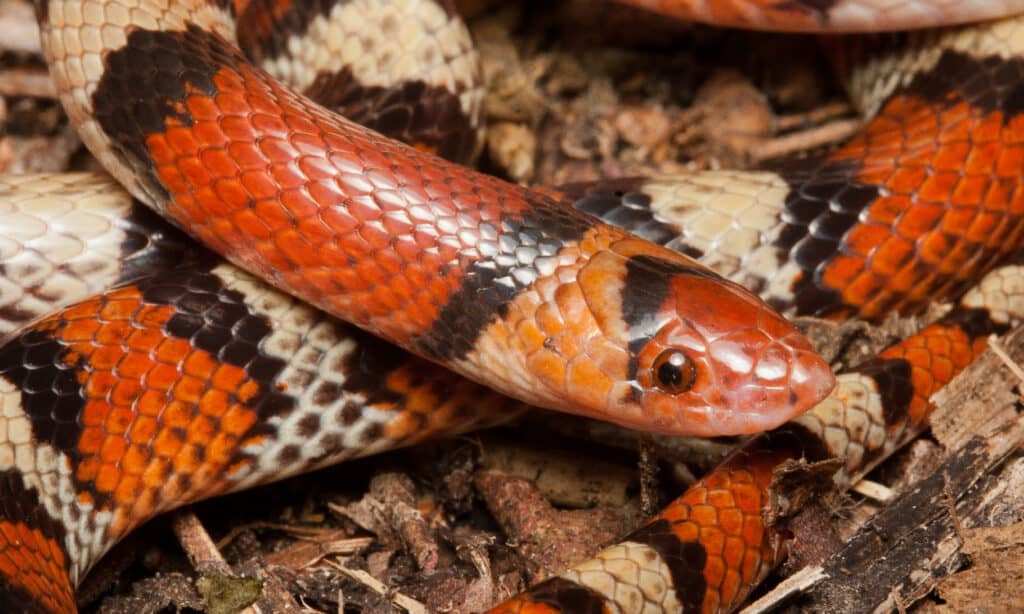
The scarlet snake is non-venomous.
©Nathan A Shepard/Shutterstock.com
Scarlet snakes are non-venomous and rarely bite when captured or picked up by humans. They are harmless and generally not dangerous to people and even pets. If grabbed or cornered, scarlet snakes prefer to hide their head beneath the coils of the body rather than attack. Some individuals lift their tails to divert any potential attack away from the head. They may also release a foul-smelling odor from glands in the base of the tail as a defense.
The scarlet snake is a nocturnal species and is active only during summer. During the day, this animal can be found beneath logs, under organic litter, or under pine debris. They are never active above the ground during the day, whereas they come out of hiding at night to look for food and are often seen crossing roads on hot summer nights.
Are Scarlet Snakes Endangered Species?
In some regions of the United States, such as Indiana, the scarlet snake is an endangered species. The greatest threats the scarlet snake population faces are habitat loss and an increasing road mortality rate. Destruction of their habitats for commercial development has led to a decline in their population. Other threats are direct or intentional killing and illegal capture of the species for the pet trade.
Scarlet Snake vs Scarlet Kingsnake
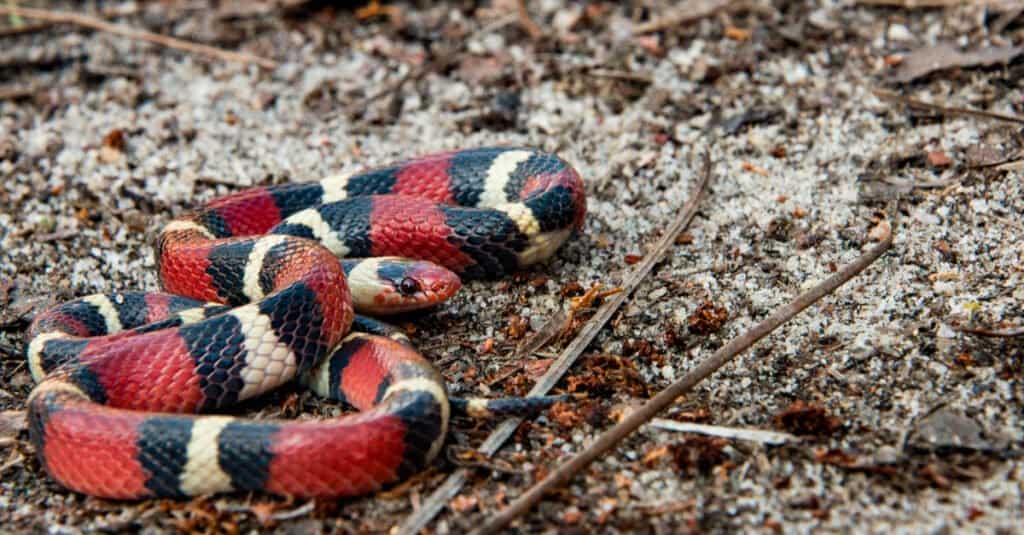
The scarlet king snake, like scarlet snakes, is tri-colored with red bands.
©Jay Ondreicka/Shutterstock.com
Like scarlet snakes, the harmless scarlet king snake is also tri-colored with red bands that do not touch yellow bands. However, the bands of the scarlet kingsnake completely encircle the body. In contrast, the scarlet snake’s bands do not extend onto the ventral side, leaving the belly solid white, grayish, or pink.
Scarlet Snake vs Coral Snake
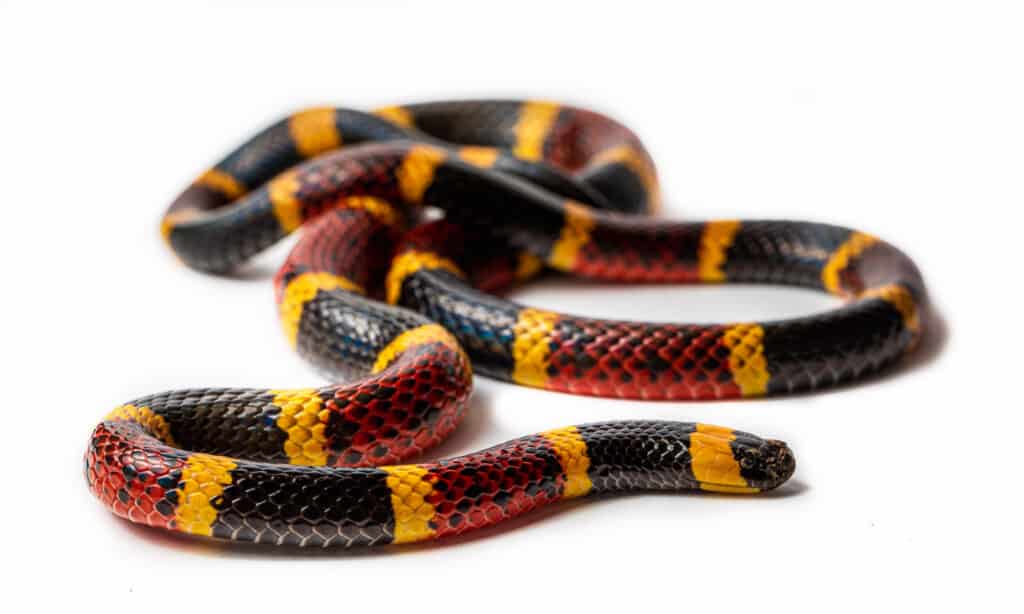
The venomous eastern coral snake has a combination of black, red, and yellow patterns.
©Scott Delony/Shutterstock.com
Also, one of the three popular tri-colored snakes, the venomous eastern coral snake has a combination of black, red, and yellow patterns. The pattern of the scarlet snake discourages predators because of its mimicry of the venomous coral snakes. In the United States, a popular rhyme used to distinguish these species is “red-touch-black, venom-lack; red-touch-yellow kill a fellow.” Coral snakes have a blunt, black snout, and their red and yellow bands touch. Scarlet snakes, on the other hand, generally have a pointed red snout, and their black and red bands touch. The red bands are also wider than bands of other colors.
Other Record-Breaking Snakes
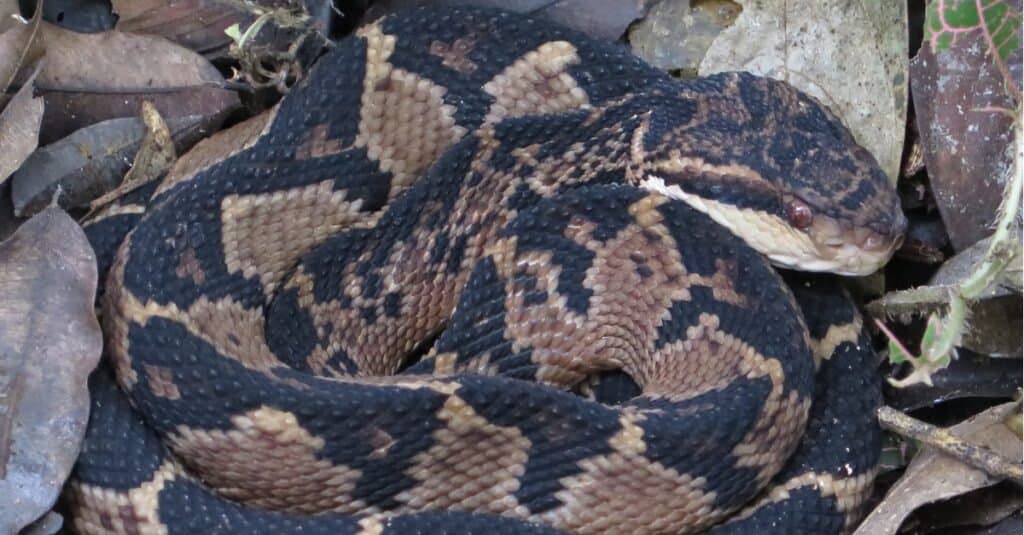
The scales of a bushmaster snake have a smoother texture toward the head.
©iStock.com/Luis Espin
The fer-de-lance or bushmaster is one of the most dangerous snakes in the Americas, earning it the Latin name “Silent Death.” It can grow up to 12 feet long and has a unique coffin-shaped head. Despite generally preferring to flee from danger, its excitable and unpredictable nature means that if disturbed, it will quickly turn around and envenomate with very nasty chemicals. Its heat-sensing pits on each side of its head give it an advantage over humans since they allow them to sense infrared light – kind of like the Terminator! This aggressive snake is responsible for 78 percent of fatal snakebites in Venezuela alone, making this already lethal species even more formidable.
Bushmaster snakes primarily feed on small mammals such as rodents, but they will also consume birds, lizards, and other reptiles. Bushmasters can reach lengths of up to 13 feet, making them one of the largest snake species in the world. These snakes use their massive size and powerful venom to ambush prey from their hiding spots in trees or among rocks and logs. Bushmaster bites are potentially fatal due to the strength of their venom. However, fatalities are rare, with proper medical attention being administered quickly.
The photo featured at the top of this post is © Fine Art Photos/Shutterstock.com
Discover the "Monster" Snake 5X Bigger than an Anaconda
Every day A-Z Animals sends out some of the most incredible facts in the world from our free newsletter. Want to discover the 10 most beautiful snakes in the world, a "snake island" where you're never more than 3 feet from danger, or a "monster" snake 5X larger than an anaconda? Then sign up right now and you'll start receiving our daily newsletter absolutely free.
Thank you for reading! Have some feedback for us? Contact the AZ Animals editorial team.






